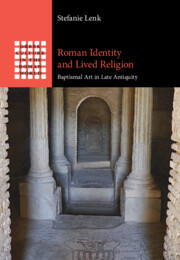Book contents
- Roman Identity and Lived Religion
- Greek Culture in the Roman World
- Roman Identity and Lived Religion
- Copyright page
- Dedication
- Contents
- Figures
- Acknowledgements
- Preface
- Abbreviations
- Introduction
- 1 The Absence of Christian Iconography and the Presence of Roman Cult and Culture in the Baptismal Complex of Cuicul, Numidia
- 2 The Use of Non-Christian Imagery in Baptisteries
- 3 The Conversion of a Personification
- Coda
- References
- Index
2 - The Use of Non-Christian Imagery in Baptisteries
Published online by Cambridge University Press: 08 February 2025
- Roman Identity and Lived Religion
- Greek Culture in the Roman World
- Roman Identity and Lived Religion
- Copyright page
- Dedication
- Contents
- Figures
- Acknowledgements
- Preface
- Abbreviations
- Introduction
- 1 The Absence of Christian Iconography and the Presence of Roman Cult and Culture in the Baptismal Complex of Cuicul, Numidia
- 2 The Use of Non-Christian Imagery in Baptisteries
- 3 The Conversion of a Personification
- Coda
- References
- Index
Summary
The chapter provides an in-depth analysis of the baptismal spaces at Henchir el Koucha (Tunisia), Myrtilis Iulia (now Mértola), and Milreu/Estói (Portugal), examining how each site incorporates pre-Christian elements into Christian contexts. At Henchir el Koucha, iconography associated with the Roman circus is ingeniously blended into a Christian framework. In the case of Myrtilis Iulia, the chapter explores a building with both palatial and baptismal features and makes suggestions about what might have motivated the representation of the mythological hero Bellerophon in baptistery. Milreu stands out for inserting a baptismal space within a pre-existing Roman monument, allowing the site’s mosaic frieze showing a marine thiasus scene to symbolize the salvific water of baptism. In each case, the incorporation of Roman elements wasn’t merely pragmatic but represented a conscious choice to articulate a multifaceted Christian identity that acknowledged and even celebrated its Roman cultural heritage. The chapter argues that these nuanced choices offer a flexible and inclusive model of Christian identity.
Keywords
- Type
- Chapter
- Information
- Roman Identity and Lived ReligionBaptismal Art in Late Antiquity, pp. 79 - 154Publisher: Cambridge University PressPrint publication year: 2025

